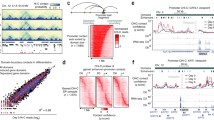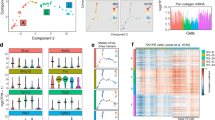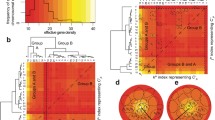Abstract
The well-established human epidermal keratinocyte (HEK) differentiation model was investigated to determine possible alterations in chromosome territory (CT) association during differentiation. The seven human chromosomes (1, 4, 11, 12, 16, 17, and 18) selected for this analysis are representative of the chromosome size and gene density range of the overall human genome as well as including a majority of genes involved in epidermal development and differentiation (CT1, 12, and 17). Induction with calcium chloride (Ca2+) resulted in morphological changes characteristic of keratinocyte differentiation. Combined multi-fluorescence in situ hybridization (FISH) and computational image analysis on the undifferentiated (0 h) and differentiated (24 h after Ca2+ treatment) HEK revealed that (a) increases in CT volumes correspond to overall nuclear volume increases, (b) radial positioning is gene density-dependent at 0 h but neither gene density- nor size-dependent at 24 h, (c) the average number of interchromosomal associations for each CT is gene density-dependent and similar at both time points, and (d) there are striking differences in the single and multiple pairwise interchromosomal association profiles. Probabilistic network models of the overall interchromosomal associations demonstrate major reorganization of the network during differentiation. Only ~40 % of the CT pairwise connections in the networks are common to both 0 and 24 h HEK. We propose that there is a probabilistic chromosome positional code which can be significantly altered during cell differentiation in coordination with reprogramming of gene expression.






Similar content being viewed by others
References
Berezney R (2002) Regulating the mammalian genome: the role of nuclear architecture. Adv Enzyme Regul 42:39–52
Bickmore WA (2013) The spatial organization of the human genome. Annu Rev Genomics Hum Genet 14:67–84. doi:10.1146/annurev-genom-091212-153515
Bolzer A et al (2005) Three-dimensional maps of all chromosomes in human male fibroblast nuclei and prometaphase rosettes. PLoS Biol 3:e157. doi:10.1371/journal.pbio.0030157
Boyce ST, Ham RG (1983) Calcium-regulated differentiation of normal human epidermal keratinocytes in chemically defined clonal culture and serum-free serial culture. J Invest Dermatol 81:33s–40s
Boyle S, Gilchrist S, Bridger JM, Mahy NL, Ellis JA, Bickmore WA (2001) The spatial organization of human chromosomes within the nuclei of normal and emerin-mutant cells. Hum Mol Genet 10:211–219
Chaly N, Munro SB, Swallow MA (1996) Remodelling of the nuclear periphery during muscle cell differentiation in vitro. J Cell Biochem 62:76–89. doi:10.1002/(SICI)1097-4644(199607)62:1<76::AID-JCB9>3.0.CO;2-Z
Chambeyron S, Bickmore WA (2004) Chromatin decondensation and nuclear reorganization of the HoxB locus upon induction of transcription. Genes Dev 18:1119–1130. doi:10.1101/gad.292104
Cremer T, Cremer C (2001) Chromosome territories, nuclear architecture and gene regulation in mammalian cells. Nat Rev Genet 2:292–301. doi:10.1038/35066075
Cremer T, Cremer M (2010) Chromosome territories. Cold Spring Harb Perspect Biol 2:a003889. doi:10.1101/cshperspect.a003889
Cremer M et al (2001) Non-random radial higher-order chromatin arrangements in nuclei of diploid human cells. Chromosome Res 9:541–567
Cremer M et al (2003) Inheritance of gene density-related higher order chromatin arrangements in normal and tumor cell nuclei. J Cell Biol 162:809–820. doi:10.1083/jcb.200304096
Cremer T, Cremer M, Dietzel S, Muller S, Solovei I, Fakan S (2006) Chromosome territories—a functional nuclear landscape. Curr Opin Cell Biol 18:307–316. doi:10.1016/j.ceb.2006.04.007
Croft JA, Bridger JM, Boyle S, Perry P, Teague P, Bickmore WA (1999) Differences in the localization and morphology of chromosomes in the human nucleus. J Cell Biol 145:1119–1131
Dale BA, Scofield JA, Hennings H, Stanley JR, Yuspa SH (1983) Identification of filaggrin in cultured mouse keratinocytes and its regulation by calcium. J Invest Dermatol 81:90s–95s
Ding H, Stojkovic B, Berezney R, Xu J (2013) Gauging association patterns of chromosome territories via chromatic median. 1296–1303 doi:10.1109/cvpr.2013.171
Eckert RL (1989) Structure, function, and differentiation of the keratinocyte. Physiol Rev 69:1316–1346
Eckert RL, Rorke EA (1989) Molecular biology of keratinocyte differentiation. Environ Health Perspect 80:109–116
Eckert RL, Crish JF, Robinson NA (1997) The epidermal keratinocyte as a model for the study of gene regulation and cell differentiation. Physiol Rev 77:397–424
Fritz AJ, Stojkovic B, Ding H, Xu J, Bhattacharya S, Berezney R (2014a) Cell type specific alterations in interchromosomal networks across the cell cycle. PLoS Comput Biol 10:e1003857. doi:10.1371/journal.pcbi.1003857
Fritz AJ, Stojkovic B, Ding H, Xu J, Bhattacharya S, Gaile D, Berezney R (2014b) Wide-scale alterations in interchromosomal organization in breast cancer cells: defining a network of interacting chromosomes. Hum Mol Genet 23:5133–5146. doi:10.1093/hmg/ddu237
Fuchs E (2007) Scratching the surface of skin development. Nature 445:834–842. doi:10.1038/nature05659
Fuchs E, Green H (1980) Changes in keratin gene expression during terminal differentiation of the keratinocyte. Cell 19:1033–1042
Gandarillas A, Davies D, Blanchard JM (2000) Normal and c-Myc-promoted human keratinocyte differentiation both occur via a novel cell cycle involving cellular growth and endoreplication. Oncogene 19:3278–3289. doi:10.1038/sj.onc.1203630
Gazel A et al (2003) Transcriptional profiling of epidermal keratinocytes: comparison of genes expressed in skin, cultured keratinocytes, and reconstituted epidermis, using large DNA microarrays. J Invest Dermatol 121:1459–1468. doi:10.1111/j.1523-1747.2003.12611.x
Gdula MR, Poterlowicz K, Mardaryev AN, Sharov AA, Peng Y, Fessing MY, Botchkarev VA (2013) Remodeling of three-dimensional organization of the nucleus during terminal keratinocyte differentiation in the epidermis. J Invest Dermatol 133:2191–2201. doi:10.1038/jid.2013.66
Harnicarova A, Kozubek S, Pachernik J, Krejci J, Bartova E (2006) Distinct nuclear arrangement of active and inactive c-myc genes in control and differentiated colon carcinoma cells. Exp Cell Res 312:4019–4035. doi:10.1016/j.yexcr.2006.09.007
Heard E, Bickmore W (2007) The ins and outs of gene regulation and chromosome territory organisation. Curr Opin Cell Biol 19:311–316. doi:10.1016/j.ceb.2007.04.016
Koster MI, Roop DR (2004) Genetic pathways required for epidermal morphogenesis. Eur J Cell Biol 83:625–629. doi:10.1078/0171-9335-00387
Koster MI, Roop DR (2007) Mechanisms regulating epithelial stratification. Annu Rev Cell Dev Biol 23:93–113. doi:10.1146/annurev.cellbio.23.090506.123357
Kumaran RI, Thakar R, Spector DL (2008) Chromatin dynamics and gene positioning. Cell 132:929–934. doi:10.1016/j.cell.2008.03.004
Kuroda M et al (2004) Alteration of chromosome positioning during adipocyte differentiation. J Cell Sci 117:5897–5903. doi:10.1242/jcs.01508
Lanctot C, Cheutin T, Cremer M, Cavalli G, Cremer T (2007) Dynamic genome architecture in the nuclear space: regulation of gene expression in three dimensions. Nat Rev Genet 8:104–115. doi:10.1038/nrg2041
Lynley AM, Dale BA (1983) The characterization of human epidermal filaggrin. A histidine-rich, keratin filament-aggregating protein. Biochimica et biophysica acta 744:28–35
Malyavantham KS, Bhattacharya S, Alonso WD, Acharya R, Berezney R (2008) Spatio-temporal dynamics of replication and transcription sites in the mammalian cell nucleus. Chromosoma 117:553–567. doi:10.1007/s00412-008-0172-6
Marella NV, Bhattacharya S, Mukherjee L, Xu J, Berezney R (2009a) Cell type specific chromosome territory organization in the interphase nucleus of normal and cancer cells. J Cell Physiol 221:130–138. doi:10.1002/jcp.21836
Marella NV, Seifert B, Nagarajan P, Sinha S, Berezney R (2009b) Chromosomal rearrangements during human epidermal keratinocyte differentiation. J Cell Physiol 221:139–146. doi:10.1002/jcp.21855
Martou G, De Boni U (2000) Nuclear topology of murine, cerebellar Purkinje neurons: changes as a function of development. Exp Cell Res 256:131–139. doi:10.1006/excr.1999.4793
Mazar J, Sinha S, Dinger ME, Mattick JS, Perera RJ (2010) Protein-coding and non-coding gene expression analysis in differentiating human keratinocytes using a three-dimensional epidermal equivalent. Mol Genet Genomics 284:1–9. doi:10.1007/s00438-010-0543-6
Meaburn KJ, Misteli T (2007) Cell biology: chromosome territories. Nature 445:379–781. doi:10.1038/445379a
Misteli T (2005) Concepts in nuclear architecture BioEssays: news and reviews in molecular, cellular and developmental. Biology 27:477–487. doi:10.1002/bies.20226
Misteli T (2007) Beyond the sequence: cellular organization of genome function. Cell 128:787–800. doi:10.1016/j.cell.2007.01.028
Moll R, Divo M, Langbein L (2008) The human keratins: biology and pathology. Histochem Cell Biol 129:705–733. doi:10.1007/s00418-008-0435-6
Morey C, Da Silva NR, Perry P, Bickmore WA (2007) Nuclear reorganisation and chromatin decondensation are conserved, but distinct, mechanisms linked to Hox gene activation. Development 134:909–919. doi:10.1242/dev.02779
Nelson WG, Sun TT (1983) The 50- and 58-kdalton keratin classes as molecular markers for stratified squamous epithelia: cell culture studies. J Cell Biol 97:244–251
Osborne CS et al (2004) Active genes dynamically colocalize to shared sites of ongoing transcription. Nat Genet 36:1065–1071. doi:10.1038/ng1423
Parada LA, McQueen PG, Munson PJ, Misteli T (2002) Conservation of relative chromosome positioning in normal and cancer cells. Curr Biol 12:1692–1697
Pillai S, Bikle DD, Hincenbergs M, Elias PM (1988) Biochemical and morphological characterization of growth and differentiation of normal human neonatal keratinocytes in a serum-free medium. J Cell Physiol 134:229–237. doi:10.1002/jcp.1041340208
Pliss A et al (2014) Non-random patterns in the distribution of NOR-bearing chromosome territories in human fibroblasts: a network model of interactions. J Cell Physiol 230:427–39. doi:10.1002/jcp.24726
Radoja N, Gazel A, Banno T, Yano S, Blumenberg M (2006) Transcriptional profiling of epidermal differentiation. Physiol Genomics 27:65–78. doi:10.1152/physiolgenomics.00031.2006
Rosenberg M, RayChaudhury A, Shows TB, Le Beau MM, Fuchs E (1988) A group of type I keratin genes on human chromosome 17: characterization and expression. Mol Cell Biol 8:722–736
Spilianakis CG, Lalioti MD, Town T, Lee GR, Flavell RA (2005) Interchromosomal associations between alternatively expressed loci. Nature 435:637–645. doi:10.1038/nature03574
Stein A, Aloy P (2008) A molecular interpretation of genetic interactions in yeast. FEBS Lett 582:1245–1250. doi:10.1016/j.febslet.2008.02.020
Stein GS et al (2003) Functional architecture of the nucleus: organizing the regulatory machinery for gene expression, replication and repair. Trends Cell Biol 13:584–592
Stein GS et al (2008) Genetic and epigenetic regulation in nuclear microenvironments for biological control in cancer. J Cell Biochem 104:2016–2026. doi:10.1002/jcb.21813
Sun TT, Eichner R, Nelson WG, Vidrich A, Woodcock-Mitchell J (1983) Keratin expression during normal epidermal differentiation. Curr Probl Dermatol 11:277–291
Sun HB, Shen J, Yokota H (2000) Size-dependent positioning of human chromosomes in interphase nuclei. Biophys J 79:184–190. doi:10.1016/S0006-3495(00)76282-5
Tanabe H, Habermann FA, Solovei I, Cremer M, Cremer T (2002) Non-random radial arrangements of interphase chromosome territories: evolutionary considerations and functional implications. Mutat Res 504:37–45
Taylor JM et al (2009) Dynamic and physical clustering of gene expression during epidermal barrier formation in differentiating keratinocytes. PLoS One 4:e7651. doi:10.1371/journal.pone.0007651
Thompson SK, Seber GAF (1996) Adaptive sampling. Wiley series in probability and statistics Applied Probability and statistics. Wiley, New York
Voldgorn YI, Adilgereeva EP, Nekrasov ED, Lavrov AV (2015) Cultivation and differentiation change nuclear localization of chromosome centromeres in human mesenchymal stem cells. PLoS One 10:e0118350. doi:10.1371/journal.pone.0118350
Volpi EV et al (2000) Large-scale chromatin organization of the major histocompatibility complex and other regions of human chromosome 6 and its response to interferon in interphase nuclei. J Cell Sci 113(Pt 9):1565–1576
Watt FM (1983) Involucrin and other markers of keratinocyte terminal differentiation. J Invest Dermatol 81:100s–103s
Williams RR, Broad S, Sheer D, Ragoussis J (2002) Subchromosomal positioning of the epidermal differentiation complex (EDC) in keratinocyte and lymphoblast interphase nuclei. Exp Cell Res 272:163–175. doi:10.1006/excr.2001.5400
Woodcock-Mitchell J, Eichner R, Nelson WG, Sun TT (1982) Immunolocalization of keratin polypeptides in human epidermis using monoclonal antibodies. J Cell Biol 95:580–588
Zaidi SK et al (2007) Nuclear microenvironments in biological control and cancer. Nat Rev Cancer 7:454–463. doi:10.1038/nrc2149
Zeitz MJ, Mukherjee L, Bhattacharya S, Xu J, Berezney R (2009) A probabilistic model for the arrangement of a subset of human chromosome territories in WI38 human fibroblasts. J Cell Physiol 221:120–129. doi:10.1002/jcp.21842
Zink D et al (2004) Transcription-dependent spatial arrangements of CFTR and adjacent genes in human cell nuclei. J Cell Biol 166:815–825. doi:10.1083/jcb.200404107
Acknowledgments
This research was supported by grants from the National Institutes of Health (GM-072131) to R.B, the National Science Foundation (IIS-0713489, IIS-1115220 and IIIS-1422591) to J.X. and R.B., and the University at Buffalo Foundation (9351115726) to R.B. A part of this research was also supported by a Mark Diamond Research Foundation grant to N.S. Dr. Andrew J. Fritz provided advise and valuable discussion. We thank Drs. Satrajit Sinha and Rose Anne Romano, Department of Biochemistry, University at Buffalo for providing the keratin antibodies and valuable advise.
Author information
Authors and Affiliations
Corresponding author
Ethics declarations
Conflict of interest
The authors declare that they have no conflict of interest.
Ethical approval
This article does not contain any studies with human participants or animals performed by any of the authors.
Electronic supplementary material
Below is the link to the electronic supplementary material.
ESM 1
(PDF 980 kb)
Rights and permissions
About this article
Cite this article
Sehgal, N., Seifert, B., Ding, H. et al. Reorganization of the interchromosomal network during keratinocyte differentiation. Chromosoma 125, 389–403 (2016). https://doi.org/10.1007/s00412-015-0546-5
Received:
Revised:
Accepted:
Published:
Issue Date:
DOI: https://doi.org/10.1007/s00412-015-0546-5




